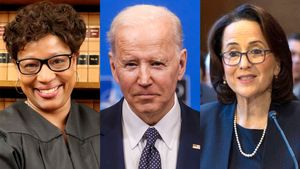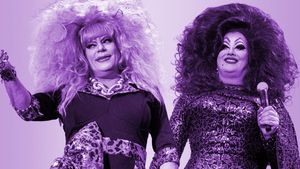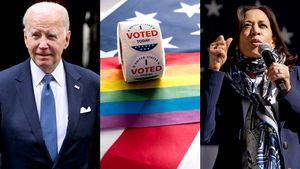Political campaigns in 2024 saw many Republicans — especially Donald Trump — and even some Democrats attack the inclusion of transgender females in girls’ and women’s sports, saying “men” shouldn’t be in these sports because of a supposed competitive advantage. On February 5, Trump signed an executive order called “No Men in Women’s Sports," with the White House claiming it is law. He warned that public schools and colleges that do not comply with the order would "risk their federal funding." But executive orders are not laws; they are directives issued by the president to federal agencies.
Legal experts note that executive orders cannot override federal civil rights protections without congressional action and are expected to face swift legal challenges. This order is expected to face those challenges as well.
Also, 26 U.S. states have placed restrictions on trans athletes' participation in school sports. But what does science say about this? Here we take a look.
Keep up with the latest in LGBTQ+ news and politics. Sign up for The Advocate's email newsletter.
In 2023, D.J. Oberlin, an assistant professor of exercise science at City University of New York’s Lehman College, conducted a comprehensive review of studies on trans participation in sports under their gender identity. It was published in Frontiers in Sports and Active Living.
“In general, studies find that trans individuals, following gender affirming hormone therapy, become more similar to their gender identity (post-transition) cisgender counterparts, or are somewhere between the expected male and female averages,” Oberlin wrote.
There are great variations among cisgender athletes, he noted — differences in height, weight, training, and more — but no one seems to worry about those. “It is expected that about 2.3% of a normally distributed population is likely to fall above two standard deviations from a population mean,” he explained. “These exceptional individuals may be those who are gifted and excel at some sport or athletic performance.”
That means that in the general population there are bound to be people who are better at some sport because of physical ability — both natural and training-affected.
“In contrast only 0.5%–0.6% of the population identify as trans,” Oberlin continued. “There is no concern for restricting individuals who are exceptionally large or small, those who are genetically gifted, or those with differing hormone concentrations or muscle mass, so long as their gender and biologic sex align.”
World Rugby, which barred trans women due to concerns about injuries, could have taken a different approach, Oberlin wrote: “Perhaps in this case, if injuries are a primary concern, rugby should have weight classes similar to other sports where body mass is an important parameter rather than a ban on trans athletes.”
There is a concern that cisgender boys and men might pretend to be trans in order to compete in female sports, thinking they might have more success there, but “there are no legitimate cases of this occurring,” he observed, adding, “The exclusion of trans individuals also insults the skill and athleticism of both cis and trans athletes.”
What do other studies say about trans athletes?
Similar conclusions came from “Transgender Women Athletes and Elite Sport,” a review commissioned by the Canadian Centre for Ethics in Sport and conducted by E-Alliance, an organization working for gender equity in sports. It looked at English-language studies published from 2011 through 2021.
“Available evidence indicates trans women who have undergone testosterone suppression have no clear biological advantages over cis women in elite sport,” says an executive summary of the report. Many athletic associations require trans women to have undergone this therapy.
Also, striking back at anti-trans forces’ claim that they are “protecting” women’s sports, the summary states, “Many social factors continue to keep women’s sport less valued than men’s: fewer resources, lack of access to sport spaces or equipment, fewer coaches and teams, sexist discrimination, having to quit sports due to sexual violence, lesbophobia, classism, racism and/or transphobia.”
“Many sport organizations circulate myths about trans women that are transphobic, harmful, and violent,” the summary continues. “For example, that trans women will overwhelm women’s sport, when trans women are in fact underrepresented in sport and especially elite sport; or that trans women are cis men in women’s clothes, a dangerous misunderstanding of trans women’s identities and experiences directly linked to trans women’s decreased safety especially in such highly gendered spaces as sport.”
In 2024, the idea that trans women athletes have an inherent over cis ones was undercut again by a study funded by the International Olympic Committee and conducted at the University of Brighton in England. It was published in April in the British Journal of Sports Medicine.
Trans women in the study had greater handgrip strength than cis women, but they had lesser jumping ability than both cis women and cis men, plus lower lung function and cardiovascular fitness than cis women.
“While longitudinal transitioning studies of transgender athletes are urgently needed, these results should caution against precautionary bans and sport eligibility exclusions that are not based on sport-specific (or sport-relevant) research,” the study concluded.
A key takeaway is that “trans women are not biological men,” Yannis Pitsiladis, one of the authors, told The New York Times.
Are there scientists who support anti-trans sports bans?
Yes, some scientists support exclusion of trans girls and women from female sports. (No one appears to worry about trans men and boys, “who they assume will not be able to compete with cisgender boys — a sexist assumption,” the Human Rights Campaign notes.)
“The point of the women’s category is to exclude male advantage, which comes as a result of testosterone,” sports scientist Ross Tucker told the BBC in 2022. “Until it can be shown that that advantage doesn’t persist [after testosterone suppression] or exist in trans women, then I would say that there’s no basis to allow trans women in. The point of all that is that if there were no evidence at all, I would say that an exclusion policy would be the prudent start point.”
In the same article, however, Joanna Harper, a sports scientist who is trans herself, provided a counterpoint. “Trans women are never going to take over women’s sport,” she said. “First of all, trans people make up roughly 1% of the population,” and they are underrepresented in sports, she pointed out.
With more than 200,000 women competing in National Collegiate Athletic Association sports in the U.S. each year, if trans women were participating in proportion to their population, there would be 1,000 to 2,000 trans women in NCAA sports annually — but “we see a handful every year,” Harper said. From 2011 to 2022, the NCAA allowed trans women to participate in women’s sports as long as they had completed a year of testosterone suppression. The NCAA changed that policy in 2022, allowing each sport’s governing body to set the standards.
NCAA President Charlie Baker recently testified before a U.S. Senate panel that fewer than 10 transgender athletes currently compete in NCAA sports. The NCAA oversees 510,000 student-athletes, meaning transgender athletes make up an infinitesimally small fraction of collegiate sports participants.
The participation of trans athletes as a human rights issue
Other factors deserve consideration in setting policy on trans inclusion in sports, according to some experts. “The focus on human rights is necessary to ensure a balance; it shouldn't be one or the other,” law professor Seema Patel told the BBC in the 2022 article. “The science should not be the turning factor on this. It has to be also a matter of law, regulation, sociology, athletes and human rights ultimately, because these athletes are individuals.”
“Biomedical studies are overvalued in sports policies in comparison to social sciences studies,” the Canadian report states, concluding, “Political, historical, and sociocultural contexts must also be intentionally considered in implementation, the framing of ‘trans inclusion’ policies, defining ‘fairness’ in sport, and participation in the hierarchy of knowledge and scientific processes.”


















































































Here's our dream all-queer cast for 'The White Lotus' season 4